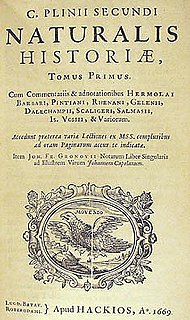Related Research Articles

Gaius Plinius Secundus, called Pliny the Elder, was a Roman author, naturalist and natural philosopher, and naval and army commander of the early Roman Empire, and a friend of the emperor Vespasian. He wrote the encyclopedic Naturalis Historia, which became an editorial model for encyclopedias. He spent most of his spare time studying, writing, and investigating natural and geographic phenomena in the field.

The Natural History is a work by Pliny the Elder. The largest single work to have survived from the Roman Empire to the modern day, the Natural History compiles information gleaned from other ancient authors. Despite the work's title, its subject area is not limited to what is today understood by natural history; Pliny himself defines his scope as "the natural world, or life". It is encyclopedic in scope, but its structure is not like that of a modern encyclopedia. It is the only work by Pliny to have survived, and the last that he published. He published the first 10 books in AD 77, but had not made a final revision of the remainder at the time of his death during the AD 79 eruption of Vesuvius. The rest was published posthumously by Pliny's nephew, Pliny the Younger.

Apelles of Kos was a renowned painter of ancient Greece. Pliny the Elder, to whom much of modern scholars' knowledge of this artist is owed, rated him superior to preceding and subsequent artists. He dated Apelles to the 112th Olympiad, possibly because he had produced a portrait of Alexander the Great.
Nicomachus of Thebes was an ancient Greek painter, a native of Thebes, and a contemporary of the great painters of the Classical period. He trained under his father Aristides, also a painter.

Protogenes was an ancient Greek painter, a contemporary rival of Apelles. As with the other famous ancient Greek painters, none of his work has survived, and it is known only from literary references and (brief) descriptions.
Parrhasius of Ephesus was one of the greatest painters of Ancient Greece.

Iaia of Cyzicus, sometimes (incorrectly) called Lala or Lalla, was a Roman painter, alive during the time of Marcus Terentius Varro.

Giovanni Battista Benaschi, or Beinaschi, (1636–1688) was an Italian painter and engraver active in the Mannerist and Baroque style.

Giuseppe Bezzuoli was an Italian painter of the Neoclassic period, active in Milan, Rome, and his native city of Florence.
Famulus was a fresco painter famous for his work in the Domus Aurea, Rome, that was commissioned by Nero.
Antidotus was an ancient Greek painter, mentioned by Pliny the Elder in his Natural History
Aristophon was a Greek painter, mentioned by Pliny the Elder.
Artemon, a Greek painter, who is recorded by Pliny to have painted a picture of Queen Stratonice, from which it is presumed that he lived about B.C. 300. He also painted 'Hercules and Deianira;' but his most celebrated works were the pictures which were carried to Rome, and placed in the Octavian Portico, representing 'Hercules received amongst the Gods;' and the 'History of Laomedon with Apollo and Neptune.'
Papirius Fabianus was an Ancient Roman rhetorician and philosopher from the gens Papirius in the time of Tiberius and Caligula, in the first half of the 1st century AD.
Bularchus was an Ancient Greek painter; Pliny indicates that he was working in the 8th century BC, during the reign of Candaules, King of Lydia.

Nicolas Colombel was a French painter, much influenced by Poussin.
Gaius Fabius Pictor made some of the earliest Roman paintings that have survived. At least some of his works were painted in 304 BC. No tradition of Roman painting exists earlier than the time of Fabius, nor does his example appear to have been followed by any of his contemporaries; for an interval of nearly a hundred and fifty years occurs before any mention is made of another Roman painter.
Luzio Dolci or Lucio Dolce was a late 16th-century Italian painter active in Castel Durante in the Province of Pesaro and Urbino in the Region of the Marche.

Peiraikos, or Piraeicus, was an Ancient Greek painter of uncertain date and location. None of his work is known to have survived and he is known only from a brief discussion by the Latin author Pliny the Elder. Pliny's passage comes in the middle of his discussion of painting in Book XXXV of his Natural History, completed about 78 AD:
It is well to add an account of the artists who won fame with the brush in painting smaller pictures. Amongst them was Peiraikos. In mastery of his art but few take rank above him, yet by his choice of a path he has perhaps marred his own success, for he followed a humble line, winning however the highest glory that it had to bring. He painted barbers' shops, cobblers' stalls, asses, eatables and similar subjects, earning for himself the name of rhyparographos [painter of dirt/low things]. In these subjects he could give consummate pleasure, selling them for more than other artists received for their large pictures.

Gaius Furius Chresimus, or Cresimus, or Cressinus, was a 2nd-century BC Greek farmer and freedman in the Roman Republic mentioned in a fragment of the lost history of Lucius Calpurnius Piso Frugi, preserved in Pliny's Natural History. Piso tells that Furius Chresimus was acquitted of accusations of witchcraft during the aedileship of Spurius Postumius Albinus, dated 191 BC. The trial took place in a period of reaction against the growing influence of Hellenism at Rome, notably led by Albinus. Both Piso and Pliny told the story of the trial for its moralizing aspect.
References
- 1 2 3 Bryan,1886-9
- 1 2 In John Bostock's 1855 translation, from "Book XXXV. Of Painting and Colours". Pliny the Elder, The Natural History. Perseus Digital Library. Retrieved 24 October 2012.